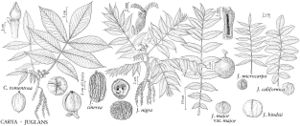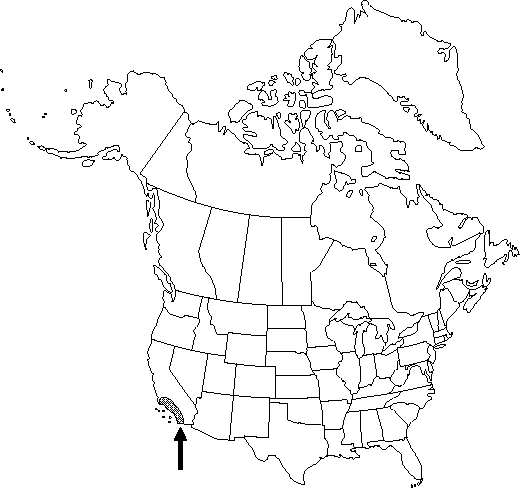Juglans californica
Proc. Amer. Acad. Arts 10: 349. 1875.
Shrubs or small trees, to 6-9 m. Bark light or medium gray, divided into rough plates. Twigs with distal edge of leaf scar notched, often shallowly so, glabrescent or bordered by poorly defined velvety patch; pith brown. Terminal buds ovoid to ellipsoid, somewhat flattened, 5-6 mm. Leaves 15-24 cm; petiole 2-5 cm. Leaflets (9-)11-15(-17), usually narrowly oblong-elliptic to lance-elliptic, occasionally lanceolate, symmetric or weakly falcate, 4.3-9.5 × 1.6-2.6 cm, margins finely serrate, apex rounded to acute; surfaces abaxially without tufts of hair in vein axils, abaxially and adaxially glabrous with scales but no hairs, main veins glandular, often sparsely so, leaflets without nonglandular hairs (except for multiradiate hairs early in season); terminal leaflet well developed. Staminate catkins 5-14 cm; stamens 15-35 per flower; pollen sacs 0.6-1 mm. Fruits 1-3, globose, 2.1-3.5 cm, smooth, at first glandular, with scattered scales, soon glabrescent; nuts depressed-globose, 1.8-2.2(-2.5) cm, shallowly grooved, surface between grooves smooth.
Phenology: Flowering spring (Mar–May).
Habitat: Hillsides and canyons
Elevation: 30-900 m
Discussion
Juglans californica is the most distinctive western walnut, but some care must be taken in identifying it. The distinctive leaflet shape of J. californica is occasionally replicated by early-season leaves of other species. Furthermore, J. californica is distinctive in lacking simple and fasciculate hairs on the leaves, but like most other walnuts, multiradiate hairs are normally present on the young vegetative growth (stems, petioles, and midribs) in the spring. The hairs are usually deciduous early in the growing season. They have short (0.1-0.2 mm), crisped rays and are never clustered or especially associated with vein axils. The fasciculate hairs found in all of our other species (except sometimes J. microcarpa) are persistent, have longer (0.3-0.4 mm), straight rays, and are concentrated in clusters abaxially in the axils of the main lateral veins.
Selected References
None.

